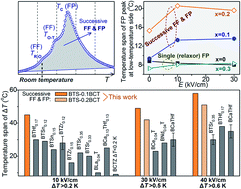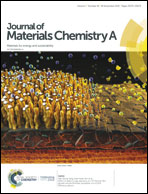Broad-temperature-span and large electrocaloric effect in lead-free ceramics utilizing successive and metastable phase transitions†
Abstract
Ferroelectric electrocaloric (EC) materials represent a promising alternative for environment-friendly cooling technologies to replace vapor-compression-based refrigeration. The general strategy is to construct the relaxor phase transition around room temperature (RT) to improve the EC effect and expand its operating temperature. However, this strategy sacrifices the inherent EC response of ferroelectrics and needs a high excitation electric field (ΔE). Guided by the physical origin of the EC effect in ferroelectrics, we designed a lead-free BaTiO3-based ceramic to realize the close, successive ferroelectric–ferroelectric and ferroelectric–paraelectric (FP) transitions, which induce a broad metastable-phase-transition region near RT. In this ceramic, the ferroelectric polar matrix and reduced energy barriers greatly facilitate the polarization rotation/reversion, maintaining the strong ferroelectric polarization but large polarization change in a wide temperature range. We achieved a large EC coefficient ΔT/ΔE of >0.3–0.35 K mm kV−1 at a small ΔE of 5–15 kV cm−1, and a high temperature change ΔT of >0.9 K (40 kV cm−1). More importantly, our system exhibits a broad temperature span of a large EC effect, which greatly exceeds the performance of previous BaTiO3-based reports employing single FP relaxor transition, even twice wider than that of them. This work offers a new general solution to design EC materials with superior performances for practical EC cooling applications.



 Please wait while we load your content...
Please wait while we load your content...